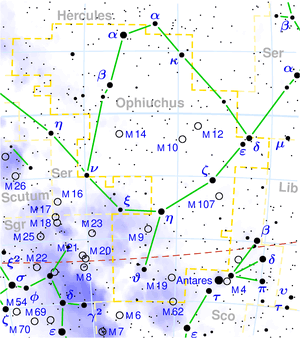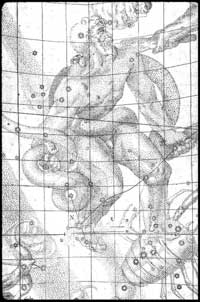|
|
Ophiuchus (Οφιούχος ) is one of the 88 constellations and was also one of the 48 listed by Ptolemy. Ophiuchus was formerly referred to as Serpentarius , the former originating in Greek and the latter in Latin, both meaning "serpent-holder". It is a large constellation located around the celestial equator between Aquila, Serpens and Hercules, northwest of the center of the Milky Way. The southern part lies between Scorpius to the west and Sagittarius to the east. Of the 13 zodiacal constellations (constellations that contain the Sun during the course of the year), Ophiuchus is the only one not counted as an astrological sign. It is best visible in the northern summer and located opposite Orion in the sky. Ophiuchus is depicted as a man grasping a serpent; the interposition of his body divides the snake constellation Serpens into two parts, Serpens Caput and Serpens Cauda, which are nonetheless counted as one constellation. Notable features The brightest stars in Ophiuchus include α Ophiuchi, called Rasalhague (at the figure's head), and η Ophiuchi. RS Ophiuchi is part of a class called recurrent novae, whose brightness increase at irregular intervals by hundreds of times in a period of just a few days. It is thought to be at the brink of becoming a type-1a supernova.[1] Barnard's Star, one of the nearest stars to the Solar System (the only stars closer are the Alpha Centauri binary system and Proxima Centauri), lies in Ophiuchus. (It is located to the left of β and just north of the V-shaped group of stars in an area that was once occupied by the now-obsolete constellation of Taurus Poniatovii, Poniatowski's Bull.) In April 2007, astronomers announced that the Swedish-built Odin satellite had made the first detection of clouds of molecular oxygen in space, following observations in the constellation Ophiuchus.[2] In approximately 40,000 years Voyager 1 probe will pass within 1.6 light years of the star AC+79 3888, which is located in Ophiuchus.[3] Notable deep-sky objects Ophiuchus contains several star clusters, such as IC 4665, NGC 6633, M9, M10, M12, M14, M19, M62, and M107, as well as the nebula IC 4603-4604. The unusual galaxy merger remnant NGC 6240 is also in Ophiuchus. There exist a number of theories as to whom the figure represents. The most recent interpretation is that the figure represents the healer Asclepius, who learned the secrets of keeping death at bay after observing one serpent bringing another healing herbs. To prevent the entire human race from becoming immortal under Asclepius' care, Zeus killed him with a bolt of lightning, but later placed his image in the heavens to honor his good works. It has also been noted that the constellation Ophiuchus is in close proximity in the sky to that of Sagittarius, which has at times been believed to represent Chiron (the mentor of Asclepius and many other Greek demigods), though Chiron was originally associated with the constellation Centaurus. Another possibility is that the figure represents the Trojan priest Laocoön, who was killed by a pair of sea serpents sent by the gods after he warned the Trojans not to accept the Trojan Horse. This event was also memorialized by the sculptors Agesander, Athenodoros, and Polydorus in the famous marble sculpture Laocoön and his Sons, which stands in the Vatican Museums. A third possibility is Apollo wrestling with the Python to take control of the oracle at Delphi. There is also the story of Phorbas, a Thessalonikan who rescued the people of the island of Rhodes from a plague of serpents and was granted a place in the sky in honor of this deed. Yet another possibility is the biblical story of Adam, who is wrestling with the serpent on a more basic level metaphorically, as even the Hebrew Qaballa has a number of man which basically embodies the meaning of the man wrestling with the serpent as half of his natural pre-disposition(358). History This constellation, known from antiquity, is one of the 48 constellations described by Ptolemy. It has also been known as Serpentarius, a Latin form of its name. The most important event in Ophiuchus' history was the Supernova of 1604, which was first observed on October 9, 1604, near θ Ophiuchi. Johannes Kepler saw it first on October 17 and studied it so extensively that the supernova was subsequently called Kepler's Supernova. He published his findings in a book titled De stella nova in pede Serpentarii (On the New Star in Ophiuchus's Foot). Galileo used its brief appearance to counter the Aristotelian dogma that the heavens are changeless. It occurred only 32 years after another supernova in Cassiopeia that had been observed by Tycho Brahe; the last supernova before then had occurred in 1054 (see Crab Nebula), and after Kepler's, no further naked-eye supernovae were observed until 1987 (see Supernova 1987a.) Astrology In the 2nd century, Ptolemy listed 29 stars in Ophiuchus. He recognised that most of those stars were north of the ecliptic (the path of the Sun through the sky); however, four of them (today known as 36 Oph, 42 θ Oph, 44 Oph, and 51 Oph) he recognized as being south of the ecliptic. Therefore, the Sun passed through the constellation of Ophiuchus as it was recognised by Ptolemy. However, Ophiuchus is not a zodiacal sign in Western astrology due to a historical system in which 12 signs divided equally into 30 degrees each are vital. At present, the Sun is in Ophiuchus from November 30 to December 17. Since Ophiuchus isn't recognized in astrology, it has no astrological symbol, unlike the other twelve. However, the 1997 PlayStation video game Final Fantasy Tactics (and later the Final Fantasy compilation Ivalice Alliance, a spin-off from Tactics), where the Zodiacs are central to the story, a symbol for Ophiuchus (there referred to by its Latin name Serpentarius) had been made: a U with a single wavy line, the serpent, running across the center. The Final Fantasy esper, Zodiark, is linked to this constellation. Citations
References * Ian Ridpath and Wil Tirion (2007). Stars and Planets Guide Links
Retrieved from "http://en.wikipedia.org/"
|
|
||||||||||||


